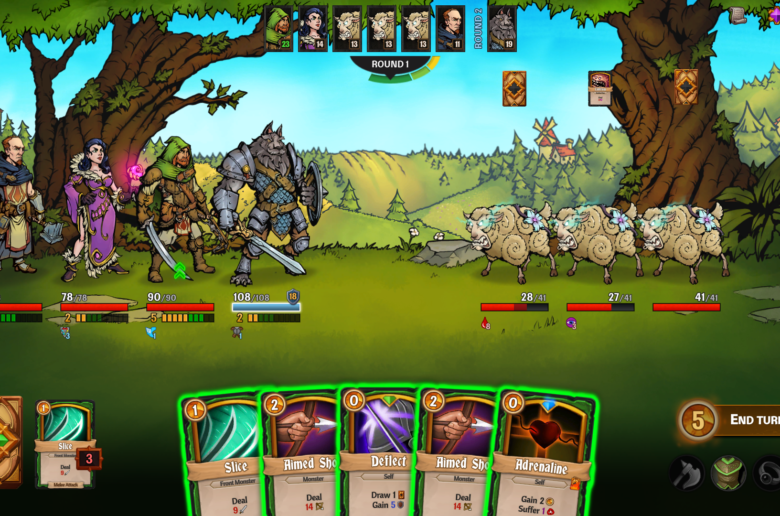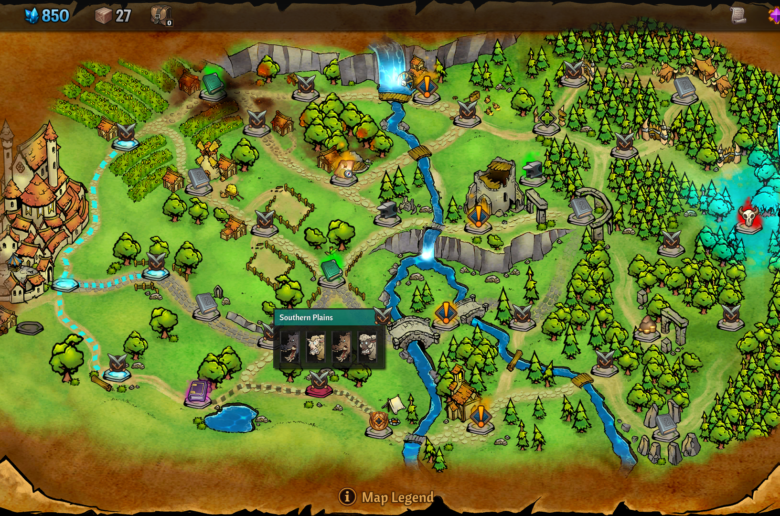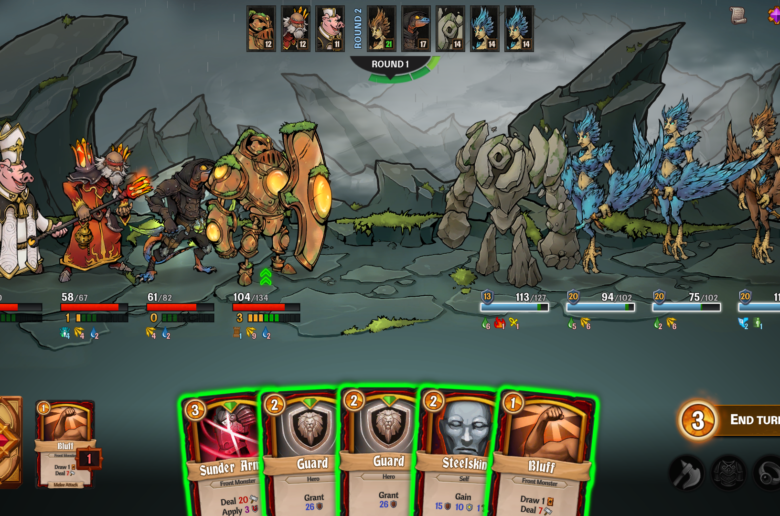a king of all trades
Across the Obelisk combines so many game genres that it is an absolute wonder that it ends up being great at them all. It is a card battler at heart, without question, having over 500 cards you can unlock and combine to create completely different play styles. It is also very much an RPG, as you control a party of characters, each with their own unique set of skills and abilities (and cards) that level up and become more powerful as you progress. It is more than deep enough to keep you occupied for many hours (I’m at 142 as of writing) in the solo campaign but seamlessly incorporates co-op play so that you can actually form an adventuring party with your friends while adventuring/deck-building/perma-leveling-your-toon together and then flip that same toon right back into your solo campaigns.
the mechanics of an epic table top card battler
Card battling really is the core mechanic of Across the Obelisk and never gets lost in the meld of the many other aspects that it successfully incorporates along the way. You have four party members, and each member has their own deck to modify and improve throughout your campaign, but while there are hundreds of cards to unlock along the way, each card can only be used by a specific class, such as Mage or Warrior. Cards have an energy cost controlling the number/power-level ratio of cards that can be played each turn and are affected by their owner’s and opponent’s stats. Of course, like any good deck builder, you will start off with a weak core set of playable cards and will unlock cards as you progress. Unlocked cards are available for all future runs, henceforth and in perpetuity!
The feel of a roguelite rpg
Still, Across the Obelisk never stops feeling like an RPG, either. You set out on your campaign with a party of four adventurers, each with a basic set of gear and spells (cards) that you slowly modify to become more powerful or swap out all together for more potent ones. Your characters have skill branches (more like either/or’s) that significantly modify their play styles and interact with their cards in different ways, but the cards themselves also have upgrade choices (also either/or’s) that allow them to become more potent in one direction or another.
In good rogue-lite fashion, each successive run is modified by the success of the previous runs, but the impacts are widespread. The characters themselves have attribute points that let you dive deeper down certain paths (the priest, for example, can become oriented more towards healing, holy damage or shadow damage, a la World of Warcraft style). The maps have various random instances associated with each node so that the runs can vary widely in opportunity, and these nodes have rarities, with rarer ones presenting the opportunity to unlock more valuable cards, items and even new characters, which you can then use in successive runs. Even the shops in the towns can be modified with resources and upgraded for future runs.
And co-op?!
I actually found out about Across the Obelisk because a friend told me to get it so we could play together. I was incredibly skeptical at first because deck builders are my jam. I had never seen one that could be played co-op before and so was, of course, expecting it to wreck a perfectly good genre. I am very happy to say that I was extremely impressed at how amazing it works.
You can play four players that each run a character in the party throughout the campaign, from combat to deck building to map choices (voted on), or have fewer players running multiple characters. The game has several save slots for both solo and co-op play and the game has multiple escalating difficulties and modifiers for runs to challenge your veteran characters, so we were able to find settings that were not too hard for my noob toons (at the time) alongside his more seasoned characters without affecting our personal campaign progressions and still contributing valuable XP to our accounts.
a well balanced combination
Across the Obelisk spent a lot of time in Early Access (even though it was great from the start), and so the devs have had much time and many iterations to get the balance right. Initially, there were certain combos and skill paths that one felt obliged to follow because they were just so damn overpowered. It has recently received its full release, and, though I’ve just started to dip my toes back into it, I am happy to report that I have yet to find any god-like loopholes that make the game Swiss cheese to overcome. It is also well-balanced in the many genres it incorporates, and I encourage you to try it even if you love just one of them and are curious about the others. It may be the best way to experience a bit of them all!





1 comment
This game rocks!